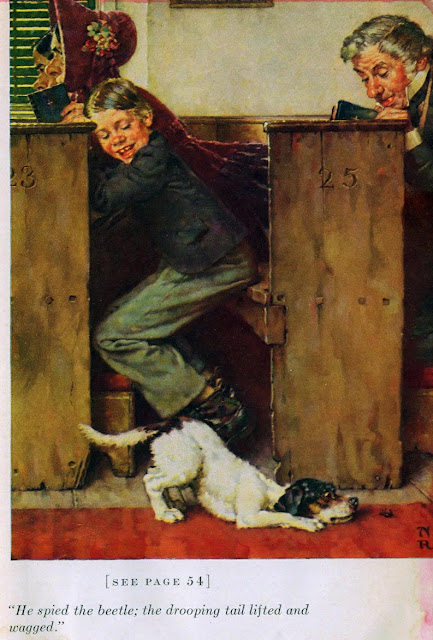Children and Worship
 | ||
| Norman Rockwell's painting of Tom Sawyer at church. He'd just let loose a pinch bug which was aggravating the dog who was then distracting the congregation. |
Tim and I remember a particularly embarrassing Sunday evening service. It's too long ago to recall the exact circumstances, but one child had misbehaved and Tim needed to take her out of the sanctuary for a few minutes to discipline her. As he grabbed the misbehaving preschooler and carried her down the center aisle she screamed, "I won't go!" Our pastor, who still happens to be our pastor even though this event took place many years ago in a different church, said from the pulpit, "Oh, yes you will!"
Sometimes all we want from our children during church is that they will sit quietly and not embarrass us. But in our better moments, probably all of us want much more. Rather than caring what they look like on the outside, we want them to join in worship as we sing and pray corporately, and we want their young hearts and minds listening and responding as God's Word is preached. We want their lives to be turned to the Lord.
Clearly God desires the presence and the praise of children. (See Ps. 8:2, Mt 21:16, Mk 10: 14, Lk 18:16.) But just how do you prepare your children to do more than just color their bulletin during church? How can parents help our children become active worship participants?
Years ago I read Parenting in the Pew by Robbie Castleman which was a real help. Happily this book is still in print. Mrs. Castleman, a pastor’s wife, writes about her passion for worship and how she taught her sons to join in worship, too. I’ve been re-reading the book recently, and have been again challenged and encouraged to continue the work of training children in worship.
First, Mrs. Castleman says, we need to examine our own view of worship. We ought to go to church to “Bless the Lord, O my soul” (Psalm 103: 1,2). But too often we go to church seeking, “Bless my soul, O Lord.” She also reminds us that worship is work and not a time to kick back and relax for an hour and a half. And worshiping alongside little ones requires even more work, but it is worth it.
What we do before Sunday morning can help set the stage for an easier lift-off. For example, especially with young children, it helps to make sure that clothes (including socks and shoes!) are laid out the night before. Baths or showers should be taken. Help your children get to bed at a reasonable hour on Saturday. (The same goes for us parents, too!) If your children have memory verses or homework, go over this on Saturday instead of scrambling on Sunday morning.
Finally, it’s Sunday morning! Keep food simple on this day. We always have yogurt and bagels for breakfast and very often something from the crockpot for lunch. Do make sure your kids have something for breakfast, though, and not something full of sugar. Both an empty stomach and one filled with junk make it hard to listen attentively.
(As an aside, I’ll put in a plug for the early morning service, if your church has one. It may not work for your family, but if your children are early risers, as so many are, the first service might be a great fit. Yes, it takes some planning and preparation to get out the door early, but often an early service works better for children’s nap and eating schedules. And tired, hungry kids aren’t best equipped to join in worship with their whole hearts. )
What do you talk about on the way to and from church? (This section of the book was convicting to me!) Do your children sense your enthusiasm for worship? Afterwards, does your conversation focus on what you learned, how the Lord convicted or taught you, or do your children hear complaints? When children start to learn how to worship, they can begin to experience God in powerful ways, and these post-service discussions can be fascinating. Sometimes before the service I’ll give my children one question to think about.
Before worship starts, make sure your children use the bathroom. Children (or adults) moving in and out during worship are pretty distracting for other worshipers, not to mention the pastor. Emergencies will arise, though! Once Tim practically rushed out of a Good Friday service with a toddler whose nose had started gushing blood. Sit with your children and eliminate distractions such as books, Sunday School papers, toys, and coloring books. (An exception I might make: Very occasionally I have created worksheets with the purpose of helping my children listen more attentively. So I might make a bingo type card with words on it that I thought the pastor might use in his sermon. When one was used, they could X out that work, or they could make tally marks for each time a particular word was spoken.)
Edith Schaeffer writes in Hidden Art how she sometimes would draw pictures to illustrate the sermon for a child sitting next to her. I’ve tried this a bit, and found it difficult to be this creative on the fly, though the child for whom I was drawing loved it. If you can find a copy of this book, you should take a look at her wonderful sermon drawings on pages 53-60. If this idea excites you, you could keep a special notebook collection of sermon drawing. It’d be a great way for your child to review the sermons.
I’ve had sons who were embarrassed to sing. Often they end up coming out with a monotone that they think sounds nondescript, but actually is worse than trying to hit the pitch. We’ve had to talk about the fact that we aren’t singing for other people or to sound good, but to “make a joyful noise to the Lord.” My current self-conscious son is starting to get over it. If you are able to find out ahead of time what songs will be sung in church that week, you can practice them at home. (I’d love it if we sang one song each week for a month, for example, to help children to learn that song well.)
Children’s Church can be a controversial topic, and each family needs to decide what is best for their children. (As in our family, this decision may even vary over time or for each individual child.) Some may want their children with them from young ages while others opt to send them to children’s church. A number of young families in our church keep their little ones with them through the singing, Scripture reading, and prayer of confession, but take them to the nursery just before the sermon. This seems like a good way to introduce little ones to worship. Sometimes you’ll see hands of very little people raised in worship, which brings joy to my heart. In Parenting in the Pews Mrs. Castleman recommends celebrating as a milestone the age when a child is “old enough” to stay for the whole service, whatever that is in your family.
OK, just one more idea. An excellent place to prepare children for church worship is during home worship. Our family devotion time is much shorter than a Sunday service, but it has been a good training ground for young ones to sit and listen actively. Tim reads a chapter of the Bible, most often asking questions as he goes. Then someone he designates prays. From time to time, most often when we have an older child home who can play guitar, we add in singing. It’s short and simple, but something we’re able to carry out daily.
Resources:
Parenting in the Pews: Guiding Your Children into the Joy of Worship
Besides the topics I've already mentioned, this book also deals with singing, prayer, confession, and more. She has an excellent chapter on the sacraments, discussing how to tell when your children are old enough to be baptized and partake in the Lord's Supper, a topic that came up recently with some friends.
 One other helpful resource is Pam Forster’s booklet A Day of Delight (Doorposts), though it has more ideas for how to celebrate Sundays at home than things to do at church. (Bonus - this book has the most excellent challah bread recipe, which my daughters have used to win many recipes at the county fair!) Also – you can check out some posts Pam has on her blog about this subject.
One other helpful resource is Pam Forster’s booklet A Day of Delight (Doorposts), though it has more ideas for how to celebrate Sundays at home than things to do at church. (Bonus - this book has the most excellent challah bread recipe, which my daughters have used to win many recipes at the county fair!) Also – you can check out some posts Pam has on her blog about this subject. Psalm 8:2 From the mouth of infants and nursing babes You have established strength Because of Your adversaries, To make the enemy and the revengeful cease.



Comments